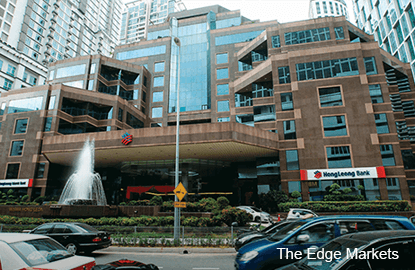
This article first appeared in The Edge Financial Daily, on January 4, 2016.
Hong Leong Bank Bhd
(Dec 31, RM13.44)
Reiterate sell with a higher target price (TP) of RM12.90: Hong Leong Bank Bhd (HLBB) has the lowest loan-to-deposit (LD) ratio among its listed peers. This suggests that despite tighter liquidity within the system, HLBB still has plenty of room to grow loans.
Management expects loans to accelerate at 8%. We believe the target is achievable despite our forecast of only 5% to 6% for the system.

The bank’s consumer loan portfolio has been gathering momentum with consumer loans rising by 11.2% year-on-year (y-o-y) in the third quarter of 2015 — exceeding the system’s growth of 8.5%.
Valuing its strength in asset quality, loan growth is underpinned by residential and non-residential mortgages.
Despite concerns about a slowdown in that segment, management noted that growth will be supported by its solid pipeline of mortgages that had been approved earlier and to be drawn down in the next one to two years.
Other areas that could spur loan growth is the small and medium enterprises (SME) retail segment, which the group has been targeting via its wide network of 283 bank branches.
We note that HLBB boasts the third-largest branch network in the country after Malayan Banking Bhd and CIMB Bank Bhd. Coming from a low base (partly due to lumpy repayments), demand for loans from the corporate sector accelerated at a solid pace of 14.7% y-o-y in September.
Predominantly a retail-based bank, we believe concerns about a rise in consumer delinquencies due to inflationary pressures, subsidy cuts and weakened sentiments could affect HLBB.
A potential increase in unemployment this round among the mass-to-mass affluent segment could affect HLBB.
Additionally, new Bank Negara Malaysia rules on rescheduled and restructured facilities in which customers will need to be classified as an impaired loan, following an increase in the credit risk such as repayment problems could also raise the bank’s allowances.
Nevertheless, we believe HLBB should be able to absorb the potential increase in credit risks. The bank is backed by a healthy asset quality, which is among the best in the industry.
Loan-loss coverage and gross impaired loan ratio stand at around 131% and 0.83% respectively.
Stretching our gross credit charge assumption to 34 basis points (bps) for financial 2016 (FY16) and FY17 to take into account a possible increase in delinquencies, our forecast is within management’s guidance of between 30bps and 35bps.
Despite some downside risks, we predict credit charges to improve in FY18 to 21bps for HLBB due to its stringent credit and risk policies.
Unlike its peers, we also note that the bank has been more guarded in growing loans in the past few years.
HLBB’s net interest margin (NIM) is among the lowest in the industry. The conservative loan growth coupled with selectively growing loans in less risky segments such as mortgages have led to margins narrowing to some 1.9% — below management’s target of keeping NIM above 2%.
Despite that, we foresee pocket of opportunities for the bank to maintain NIM by ramping up loan growth without having to compete too aggressively for deposits (due to low LD ratio) and targeting the riskier segments (such as personal loans).
While we foresee growth opportunities for HLBB, they are limited by the group’s stringent credit and risk policies, in our view. That said, we note that despite the strong pickup in loan growth, HLBB’s growth still trails behind its peers.
As a result, the group’s market share has stayed little changed at 7.8% to 7.9% since 2013. Management’s aversion to risks has also resulted in NIMs falling below 2%.
Given views of further macro slowdown and deteriorating asset quality ahead, we believe HLBB should be able to better withstand oncoming challenges due to its solid asset quality. While NIM could still come under strain due to competitive pressures in the deposit space, the ability to grow loans, which are backed by a strong base of retail deposits could help lend some support to margins.
Overseas, management expects operations in Cambodia and Singapore to remain robust although we foresee a further downside risk stemming from Bank of Chengdu.
This is underpinned by the tough business environment in China and targeted slowdown in certain segment (such as SME) to manage risk. China accounts for around 15% of the group’s profit before tax (PBT).
In addition to tweaking our credit charge estimates up, we lower our growth forecast for Bank of Chengdu.
Estimated loan growth of 8% for FY16 to FY18 should help drive net interest income (NII), although a further risk of margin compression will put a lid on top-line growth.
Non-interest income is expected to remain weak due to ongoing market volatilities. — TA Securities, Dec 31